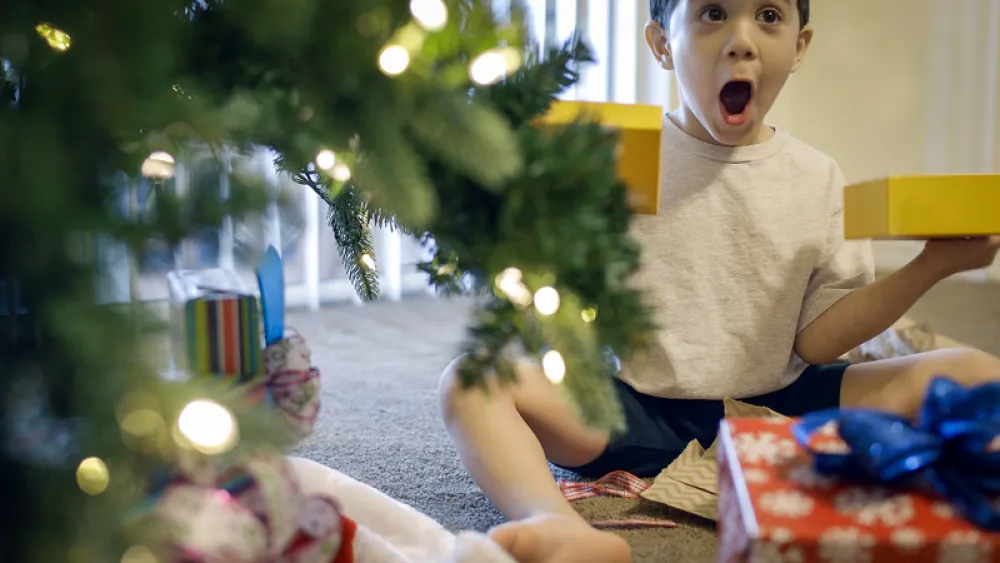




Family Health
The 12 Tips of Holiday Gifting
Published: Dec. 10, 2019

During the Christmas season, high on many parents’ “to-do” list is finishing up their Christmas shopping. In addition to the chaos of battling crowds and parking, trying to find the best online deal, or taking in to consideration a child’s wish list, many have an overwhelming amount of questions when it comes to gift giving:
- What is right for the child’s age or development?
- Should I get an electronic device or something simple?
- Is what I’m buying safe?
- Is this toy educational?
12 Things To Consider for Kids
Fortunately, you don’t have to make such a decision blind. I often give my parents tips and recommendations to make sure whatever a child receiving, they can be both excited and safe this holiday.
- Choose a gift that is age and developmentally appropriate. The biggest tip I (and the American Academy of Pediatrics) can give, is to choose a toy that matches the age, development and interests of the child. Most toys include a label with a recommended age range.
- Focus on toys that help development. Toddlers and infants are rapidly developing and have wildly varying skills. Toys which focus on fostering and developing those skills, such as sorting and stacking toys, or those which can be manipulated, help with motor and cognitive skills.
- Bigger can be better. With young children, err on the side of caution when deciding between toys with large versus small pieces. All pieces should be larger than a child’s mouth to prevent choking.
- Quality matters. Regardless of the specific gift, always check to make sure that the gift is well made. Poor stitching on buttons, zippers or clothing, as well thin or poorly-made plastic can be prone to breaking. This can lead to gifts becoming unintentional choking hazards or pieces that are sharp and may harm a child.
- Be cautious with magnets. Small magnets or those poorly held in place can lead to ingestion dangers if they come loose and are swallowed. An ingested magnet can lead to serious injury or death. Keep such gifts or toys away from young children and call your doctor immediately if you believe your child may have swallowed a magnet.
- Choose wisely with batteries and electricity. Much like magnets, small batteries (especially button/watch batteries) can lead to choking, burning or shock dangers if improperly secured. Securely latched toys with batteries are much safer and a better option for children under 10. Any toy that must be plugged into an electrical outlet can lead to electric shock or injury. Any electrical toys should be labelled as UL approved.
- Read the label and instructions. Most toys and gifts, especially those with moving parts or lots of little pieces, come with labels and instructions outlining their use and safety. Always review such information before letting your child begin playing.
- Avoid airborne gifts. Toys and gifts intended to be shot into the air, such as model rockets, or those powered by air, such as drones, can lead to serious eye injuries or pose dangers from above. If you buy them, just make sure they are used safely, with supervision, and are age-appropriate.
- Digital dangers. Tablets, computers, gaming systems and phones make popular gifts for older children and adolescents. Be sure to think about their intended use, unintended dangers, and any rules or restrictions that should be placed on them. The AAP has recommendations for mindful electronic use as well as age guidelines and recommendations for younger children when it comes to screen time and gaming.
- Preparation is key. Prior to wrapping or giving gifts to children, make sure that any loose objects, tags, strings or ribbons are removed and the gift is ready to be used. If your children are anything like mine, you’ll be hard-pressed to get it back after they have it.
- Storage shouldn’t be forgotten. Where and how to keep any existing and new gifts is important to ongoing safety and use. Toys and items for older children should be kept separate from infants and toddlers. They should have a specific location and manner of storage to help children understand when they should and shouldn’t be used. Any toy boxes should be without a latch or lid, and preferably with holes for ventilation to prevent any unintentional injury.
- Be careful with crib toys. When giving objects to infants in a crib (especially those under 1), be aware of safe sleep recommendations. Soft objects, such as stuffed animals or other toys, as well as loose bedding and pillows can increase the risk of suffocation, strangulation or entrapment. Hanging or attaching toys must be able to be affixed out of a child’s reach and removed once the child can push up on her hands and knees or by five months, whichever is sooner.
Enjoy the Present
For as stressful as gift giving and the holidays can be, keep in mind that most children are more excited by the anticipation and build up as well as the actual opening than what individual gifts might be. Focus on being present and enjoying the time with them to make the holidays special. As always, don’t hesitate to ask your Methodist Physicians Clinic pediatrician if you have any other questions or concerns!


